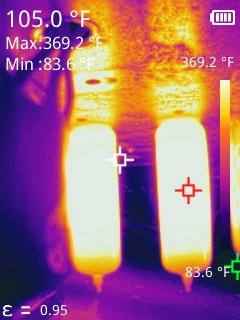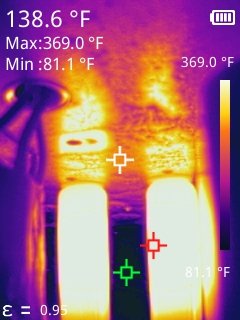I found a working 5U4 in my random tube box and connected it up. I'm getting 390 volts with just bleeder loading, and with the two 6BQ5's in and biased at about 7 watts each I'm seeing about 369 volts. Bias current is sitting at about 19mA per tube, using separate bias controls for each tube to compensate for some tube mismatch. With a 1KHz sine wave coming into the PI, I can get about 15 watts RMS into a 50-ohm load with some crossover and saturation distortion. If I back down the input to fairly clean sine wave, its about 12 watts RMS. I did change the .1 power tube coupling caps to .047uf, but left the PI input caps at .1uf. I ran a heat and current test by injecting a 1KHz sine wave at a level which gave the highest plate current draw and running the amp at that level for 2 minutes. The tube temperature never went above 370 degrees F, and the current draw held steady with no surging. After removing the input and allowing the amp to come back down to idle current/temperature, the envelopes were holding steady at about 369 degrees F. See thermal images below. The "Max:" reading near the top left of the image is the envelope temperature.
Max load temperature:

Idle load temperature:

The amp has been powered up with different input levels for roughly an hour and no misbehavior whatsoever has been observed. I think I can now move on to adding some pre-amp stages.
Max load temperature:

Idle load temperature:

The amp has been powered up with different input levels for roughly an hour and no misbehavior whatsoever has been observed. I think I can now move on to adding some pre-amp stages.


